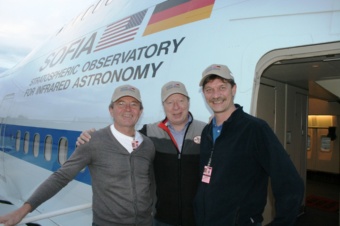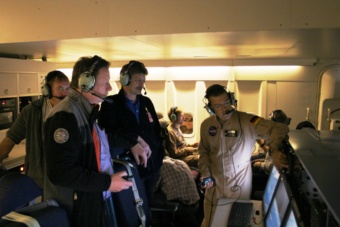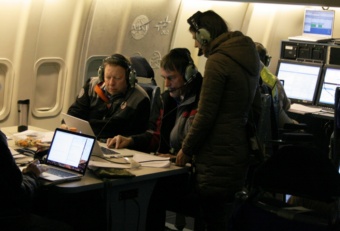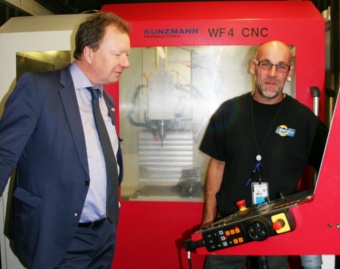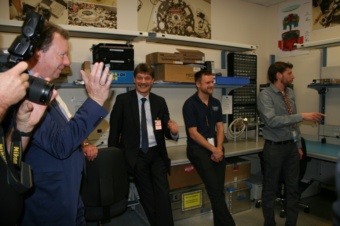-
Georg Fundel (Manager of the Stuttgart Airport),
Wolfram Ressel (Rector of the University of Stuttgart) und
Stefanos Fasoulas (Manager of the Institute of Space Systems)
shortly before boarding (from left to right).
Copyright: DSI.
On October 27 th the Rector of the University of Stuttgart, Prof. Wolfram Ressel took off on board SOFIA, the Stratospheric Observatory For Infrared Astronomy, from the NASA Armstrong Flight Research Center (AFRC) research aircraft faciity in Palmdale, Calif. He was joined by Manager Prof. Georg Fundel, Director of the Germans SOFIA Institute (DSI) Prof. Alfred Krabbe, and Prof Stefanos Fasoulas, Director of the Institute of Space Systems. The astronomical targets of this observation night were the Andromeda galaxy (M31), the Whale galaxy (NGC 4631), the planet Mars, the interstellar medium of our Milky Way galaxy, and the star formation region Messier 42 in the Orion nebula. The Rector of the University of Stuttgart was one of the first to view the data obtained during the flight.
-
- Oliver Zeile from DSI explains the displays for the Telescope to
Wolfram Ressel and Stefanos Fasoulas
(from left to right; in the back: Klaus Zintz, media). - Copyright: DSI.
-
- Alfred Krabbe explains the FIFI-LS Data of the Andromeda galaxy (M31)
to Wolfram Ressel. Maria Kapala (right) has proposed these observations
and inspects the first views on the screen. Copyright: DSI.
Wolfram Ressel was enthusiastic about his flight: “I already knew long before that SOFIA is a highly interesting project. But to experience personally how German and US engineers, technicians, scientists, and pilots make the best out of each minute of the night by highly concentrated and excellent team work …that is really impressive!”
Ressel already had inspected the Stratospheric Observatory For Infrared Astronomy in California
in 2007. In May 2014 SOFIA finally reached its official Full Operational Capability. Hence, on
Tuesday, October 27
th at 9:18 pm local time this prominent group of visitors ascended to the stratosphere
on board the highly modified Boeing 747SP. Approximately half an hour later, at an altitude of
about 40,000 feet, the telescope door, approximately 3x4 meters in size, opened and the telescope’s
operation was initiated. At this altitude the amount of water vapor in Earth’s atmosphere is only
minor and hence astronomers have an unobstructed view for infrared observations of celestial
objects. The science instrument mounted on the teescope this night was U. Stuttgart’s
Field-Imaging-Far-Infrared Line Spectrometer, FIFI-LS. DSI director Alfred Krabbe explained the
main principles of this highly complex detector: “FIFI-LS is one of a very view astronomic
instruments that – like a human eye – is able to detect different brightness contours and different
colors at the same time.”
-
Andreas Reinacher and Yannick Lammen (both DSI; from right)
demonstrate the test bench of SOFIA's secondary mirror. - Copyright: DSI.
Ahead of his flight, Prof. Ressel took a tour through SOFIA. DSI California site head Michael Hütwohl and his team showed Ressel the science instrument laboratories, test stations, and maintenance areas. “It makes me extraordinarily proud that the colleagues of the University of Stuttgart contribute to the daily and nightly success of the SOFIA mission through their exceptionally commitment” said Ressel, summarizing his impressions.
ATUS directly connects the lecture room with space
After his flight Prof. Ressel officially transferred management of the U. Stuttgart instrument FIFI-LS to the SOFIA program. From January 2016 on, FIFI-LS will be operated under the responsibility of the SOFIA Science Mission Operations enter, although it will still be supported by the DSI. Afterward, continuing his visit to California, the Rector inaugurated ATUS, the remote controlled “Astronomical Telescope of the University of Stuttgart” situated in the Sierra Nevada at an altitude of about 1400 meters. With ATUS, night observations can easily be transmitted to lecture halls back in Stuttgart during local day time. “This is an excellent possibility for our students to test remote controlled processes that are relevant for space science under real conditions during their time at the university,” Ressel pointed out.
Prof. Ressel also visited the NASA Ames Research Center (ARC), where the SOFIA Science Mission Operations center is located, and had dinner with deputy German Consul in San Francisco, Johannes Bloos.
Kontakt: Dörte Mehlert, Email: mehlert@dsi.uni-stuttgart.de; Tel.:0711 -
685-69632



